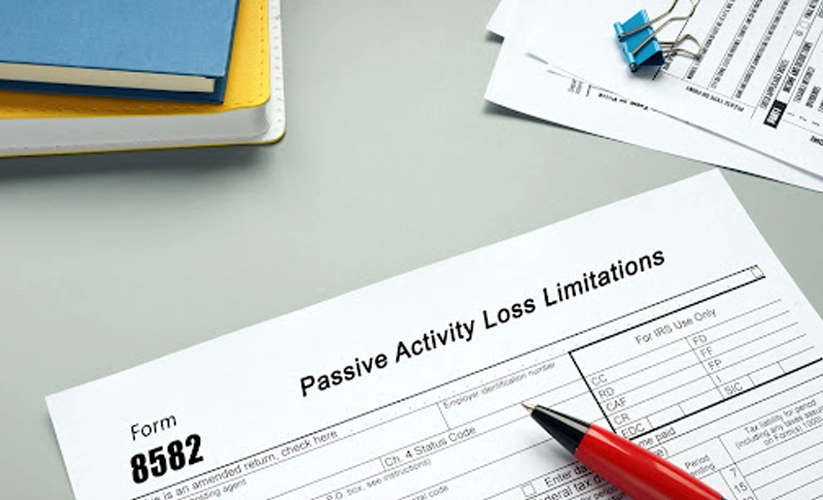
Losing money sucks. Having to tell the IRS about it might be embarrassing and a smart tax strategy.
Form 8582 – Passive Activity Loss Limitations brings forward one of the general rules of taxing passive income. Usually, you’re not allowed to deduct losses in excess of income earned, whether you’re earning by passive or active effort. This form is an essential component of your tax returns, specifically for individuals with passive activities such as real estate investments or businesses. Its purpose is to limit the amount of passive activity losses that can be deducted against nonpassive income.
What Does Passive Activity Loss Mean?
Are you familiar with the passive activity loss rules?
Passive activity loss refers to the losses incurred from endeavors in which the taxpayer does not materially participate. These can include real estate investments, limited partnerships, or any other business ventures where the taxpayer has a limited role.
The key thing to note about passive activity loss is that these losses can only be offset against passive income. This means that if you have passive losses, you can only use them to reduce any passive income you have. You cannot use these losses to reduce the taxes on your nonpassive income.
Why does this matter? Well, it’s important to understand because it affects how you calculate your taxes. The IRS requires you to report income and losses separately, as well as separate reporting of passive and active earnings.
The passive activity loss rules keep you from deducting too much from losses. If your adjusted gross income (AGI) is greater than $100,000, then you can’t deduct much of your losses, if any, from other real estate rentals.
So, when you’re filing your tax returns, make sure to carefully account for your passive activity loss and ensure that you’re only offsetting it against passive income. This will help you stay in compliance with the IRS guidelines and minimize any tax implications.
In summary, passive activity loss refers to losses incurred when the taxpayer does not materially participate. These losses can only be offset against passive income and have limited implications on taxes. Stay informed about these concepts to ensure accurate and compliant tax filing.
What Counts as Passive Activity?
Passive activities typically include real estate investments, limited partnerships, and any other business ventures where you have a limited role and do not materially participate. Real estate activity could count as passive if you’re collecting rents or managing structures. Commercial property owners could face regular passive activity, especially if they’re not directly running the operation. They’re categorized as passive because the taxpayer does not actively engage or provide significant involvement in running the operation.
Form 8582 is an essential tool in ensuring compliance with IRS guidelines and minimizing any tax implications. It helps you accurately calculate the limitations on your passive activity losses, ensuring that you correctly offset them against passive income.
Remember, you cannot use these losses to reduce the taxes on your nonpassive income.
How Does a PAL Affect Your Taxes?
When it comes to tax returns, understanding how a Passive Activity Loss (PAL) can affect your taxes is crucial. A PAL occurs when your expenses toward a passive income exceeds the income you got from it. This loss, reported on Form 8582 – Passive Activity Limitation, has specific implications on your tax situation and income limitations.
Firstly, a PAL can only offset passive income. You cannot use these losses to reduce the taxes on your nonpassive income. So, if you have passive income, you can use your PAL to reduce or eliminate the tax liability associated with that income. However, if you have no passive income or if your PAL exceeds your passive income, the excess loss will usually be carried forward to future years.
It is also essential to note that the IRS imposes limitations on PAL deductions. The amount of PAL that you can deduct in a given year depends on your income level and your participation in the passive activity. The IRS classifies participants as material participants or non-material participants, and these distinctions affect the deductibility of PAL.
By accurately completing Form 8582, you can ensure compliance with IRS guidelines and calculate the limitations on your passive activity losses effectively. This will help you offset your PAL against any passive income you may have, minimizing any tax implications. It is always advisable to consult a tax professional or use customizable forms to ensure accuracy and maximize your deductions.
Understanding how a PAL affects your taxes is vital for accurately reporting your income and losses, minimizing tax liabilities, and maintaining compliance with IRS regulations.
How Do You File Form 8582?
When it comes to filing Form 8582, Passive Activity Loss Limitations, the process can be straightforward if you follow these step-by-step instructions.
First, gather all relevant information, such as real estate investments or other passive income sources.
Next, fill out Form 8582, which is used to calculate your passive activity loss limitation. This form helps determine the amount of passive activity losses that can be deducted on your tax returns.
Make sure to correctly report your income and losses on the form, distinguishing between passive and nonpassive income.
If you’re filing Form 8582 as part of a joint return, complete a separate form for each spouse. Otherwise, your separate returns will need their own version of Form 8582. If you’re filing form 1041 – fiduciary returns, then the form should be completed by the estate or trust.
Once you have filled out the form, carefully review it to ensure accuracy.
Finally, attach Form 8582 to your tax return and file it with the IRS.
By following these simple instructions, you can effectively file Form 8582 and ensure that your passive activity losses are properly reported and deducted within the limits set by the IRS.

Nick Charveron
Nick Charveron is a licensed tax practitioner and Partner & Co-Founder of Community Tax, LLC. As an Enrolled Agent, the highest tax credential issued by the U.S. Department of Treasury, Nick has unrestricted practice rights before the IRS. He earned his Bachelor of Science from Southern Illinois University while serving with the U.S. Army Illinois National Guard and interning at the U.S. Embassy in Warsaw, Poland. Based in Chicago, Nick combines his passion for finance and real estate with expertise in tax and accounting to help clients navigate complex financial challenges.







